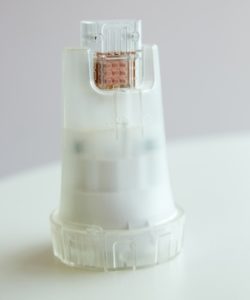The science of personalized screening and testing for the HIV virus has officially entered the computer age. British scientists have developed an HIV test on a USB stick, which quickly and accurately measures the levels of the virus in a person’s blood.

Created by scientists at Imperial College London and DNA Electronics, the device can detect HIV by using a drop of blood, which creates an electrical signal that can be read by a computer, laptop or handheld device. The research, which was published in the journal Scientific Reports, also guarantees results in less than 30 minutes.
The technology would allow HIV patients to manage their conditions more effectively in remote locations, and it could provide life-saving measures across several developing nations, where many of the highest numbers of HIV infections exist.
The current HIV screening process, where virus detection is determined by sending blood samples to a laboratory, can take up to three days or longer and is not available in many parts of the world. Also, this type of testing doesn’t screen for viral levels, because its data relies on antibodies and only notes if a person has been infected.
Patients Can Monitor Their Own HIV Viral Levels

The USB disposable test allows HIV patients to monitor the progress and status of their own treatment by monitoring the levels of the virus in the bloodstream. This kind of screening is essential for effectively treating patients with HIV.
Viral levels in the bloodstream can tell doctors if a patient’s medication has stopped working. This sometimes happens when an increase in the bloodstream causes a resistance to drugs. And that can dramatically impact the care and treatment regimen for HIV patients.
“Monitoring viral load is crucial to the success of HIV treatment,” said Dr. Graham Cooke, senior author of the research from the Department of Medicine at Imperial. “At the moment, testing often requires costly and complex equipment that can take a couple of days to produce a result. We have taken the job done by this equipment, which is the size of a large photocopier, and shrunk it down to a USB chip.”
How the HIV USB Stick Test Works
A small sample of blood is placed on a spot of the USB stick, which uses a mobile phone chip. If any HIV is detected in the sample, it triggers an acidity change where the chip transforms into an electrical signal. This is sent to the USB stick, and the results are shown on a computer or electronic device.
For a newer form of HIV screening, the USB stick test is highly effective. It was 95 percent accurate over 991 blood samples, and the average window to get the reading was 20.8 minutes.
Eventually researchers hope that this style of HIV testing will allow patients to monitor their virus levels with the same ease and convenience that diabetics now manage their blood sugar levels.
Ronke Idowu Reeves is a writer and journalist who hails from Brooklyn, NY. Her news and entertainment stories have appeared on WABC-TV-New York, Fox News Channel, VH1, BET.com plus in Sundance Film Festival’s Sundance Daily Insider and People Magazine.


![How To: ‘Fix’ Crepey Skin [Watch]](https://cdn.vitalupdates.com/wp-content/uploads/2017/05/bhmdad.png)












